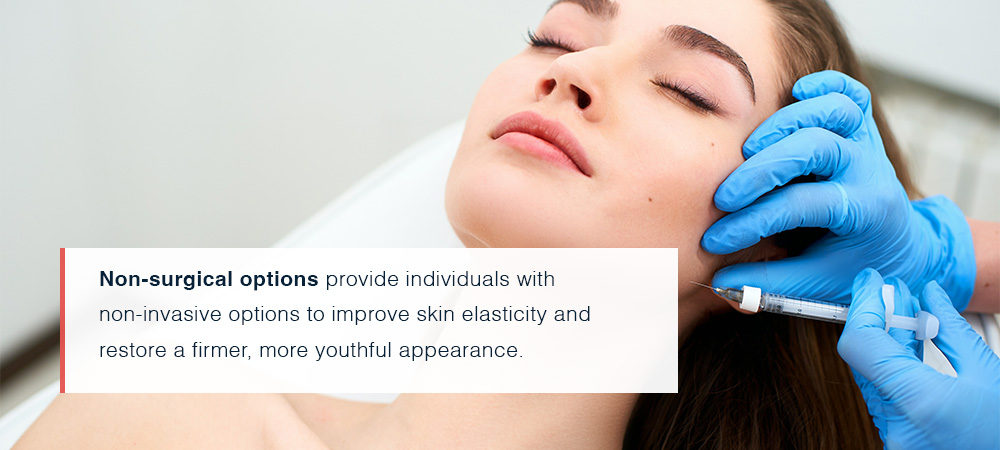What to Do About Saggy Skin

Saggy skin can be a common concern as we age and our bodies change, affecting our appearance and self-confidence. Many individuals seek solutions to combat skin laxity, whether it’s due to the natural aging process, weight fluctuations, or other factors.
Understanding the causes and treatments of sagging skin can help you find the right solution for your needs. From non-surgical treatments and skin care tips to surgical procedures, this guide will help you make informed decisions about your skin care journey.
Causes of Saggy Skin
If you’re dealing with sagging skin, you might be able to address some of the causes early to prevent further sagging. Let’s explore the primary causes of saggy skin:
- Aging: The natural aging process is one of the most significant causes of saggy skin. Our skin’s elastin and collagen production — essential proteins for skin elasticity — decrease as we age. This structural support loss leads to sagging and wrinkles.
- Ultraviolet radiation: Prolonged exposure to ultraviolet rays from the sun or tanning beds can accelerate skin aging. Ultraviolet radiation damages collagen fibers and elastin, causing the skin to lose its firmness and elasticity.
- Genetics: Genetic predispositions play a role in skin laxity. Some individuals may inherit genes that result in weaker collagen and elastin fibers, making them more prone to saggy skin as they age.
- Weight fluctuations: Rapid weight gain and loss can strain the skin’s elasticity. When someone gains weight, their skin stretches. If weight is lost quickly, the skin may not fully bounce back, leading to sagging areas.
- Smoking: Smoking is detrimental to skin health. It narrows blood vessels, reducing the oxygen and nutrients reaching the skin and breaking down collagen and elastin, accelerating skin aging.
- Poor diet: A diet lacking in essential nutrients like vitamins, antioxidants, and proteins can negatively impact skin health. These nutrients are crucial for collagen production and maintaining skin elasticity.
- Environmental factors: Pollution and environmental toxins can damage skin cells and disrupt collagen production, contributing to skin sagging over time.
- Gravity: Gravity is a constant force acting on our skin, causing it to sag over time. This is particularly noticeable in the cheeks, jowls, and neck over the years.
- Hormonal changes: Hormonal fluctuations, especially during menopause, can affect skin elasticity. Decreased estrogen levels can decrease collagen production and contribute to saggy skin.
- Lifestyle choices: Poor skincare habits, like not moisturizing, not using sunscreen, or not staying properly hydrated, can exacerbate saggy skin over time.
Non-Surgical Treatments

Non-surgical treatments offer effective solutions for less severe cases of saggy skin. These non-surgical options provide individuals with non-invasive options to improve skin elasticity and restore a firmer, more youthful appearance. Here are some non-surgical options that can help restore the look of saggy or wrinkly skin:
- Dermal fillers: Injectable dermal fillers containing substances like hyaluronic acid can be used to plump and lift sagging areas. They fill in wrinkles and stimulate collagen production, resulting in smoother, tighter skin. Popular fillers for this purpose include Juvederm and Restylane.
- Botox: While primarily known for its wrinkle-reducing effects, Botox can also be used to treat mild sagging by relaxing specific facial muscles. This can lift and tighten the skin in areas like the forehead and around the eyes.
- Radiofrequency (RF) therapy: RF treatments use controlled heat to stimulate collagen production and tighten loose skin. These procedures are gentle and can target various body areas.
- Ultrasound therapy: Ultherapy is an FDA-approved treatment that uses ultrasound energy to stimulate collagen production. It lifts and tightens sagging skin on the face and neck, providing natural-looking results.
- Thread lifts: Thread lifts involve inserting dissolvable threads beneath the skin to lift and tighten saggy areas. Over time, the threads encourage collagen production, further improving skin elasticity.
- Chemical peels: Chemical peels help improve skin texture and firmness by removing the outermost layer of damaged skin. They stimulate collagen production and can reduce the appearance of mild sagging.
- Microdermabrasion: This exfoliation technique removes dead skin cells, encouraging the growth of new, firmer skin. While not a primary treatment for saggy skin, it can complement other therapies.
- Topical skincare products: Using skin care products containing ingredients like retinol, peptides, and antioxidants can promote collagen production over time. Regular use can help maintain results from other treatments.
- Laser therapy: Non-ablative laser treatments stimulate collagen production and tighten your skin. These lasers are less invasive than ablative options and require minimal downtime.
- Intense Pulsed Light (IPL): IPL heats cells under the skin with light. With multiple treatments, IPL can help reduce signs of aging.
Surgical Options
Surgical options for sagging skin provide more dramatic and long-lasting results, making them ideal for individuals with moderate to severe skin laxity. Surgical options are more invasive than non-surgical options, but they can offer patients an effective solution for their skin concerns.
Let’s look at several popular surgical procedures for addressing the appearance of sagging skin:
- Arm lift (Brachioplasty): An arm lift addresses sagging skin on the upper arms. Excess skin and fat are removed during the procedure while the remaining skin is tightened. This surgery results in firmer, more toned arms and enhanced overall arm contour.
- Thigh lift (Thighplasty): A thigh lift targets sagging skin and excess fat in the thighs. The surgeon removes the surplus tissue and reshapes the thigh area. This procedure is particularly popular for individuals who have experienced significant weight loss and are left with loose skin.
- Tummy tuck (Abdominoplasty): A tummy tuck is for addressing saggy skin and weakened abdominal muscles. The surgeon removes excess skin and fat, tightens the abdominal muscles, and repositions the belly button for a flatter, more toned abdomen. It’s a common choice for post-pregnancy or after substantial weight loss.
- Face and neck lift (Rhytidectomy): Face and neck lifts are often performed together to address facial sagging, wrinkles, and jowls. The surgeon tightens underlying muscles and re-drapes the skin to create a more youthful appearance. This procedure can provide a significant improvement in facial and neck contour, reducing the effects of aging.
Transform Your Skin With Southern Plastic & Reconstructive Surgical Institute
If you’re looking to enhance your look and boost your confidence, turn to the experts at SPRSI. Our world-class team is dedicated to helping Nashville residents achieve their desired results. With a holistic approach and an emphasis on patient care, you’ll get the personalized treatment you deserve.
Our outstanding board-certified plastic surgeon, Dr. Brought, has extensive experience in cosmetic surgery. Whether you want to address wrinkled skin or invest in our body procedures, we have the expertise and commitment to deliver natural-looking results.
Get started with your transformation and schedule your consultation with SPRSI online. Take the first step toward a more confident you today!


